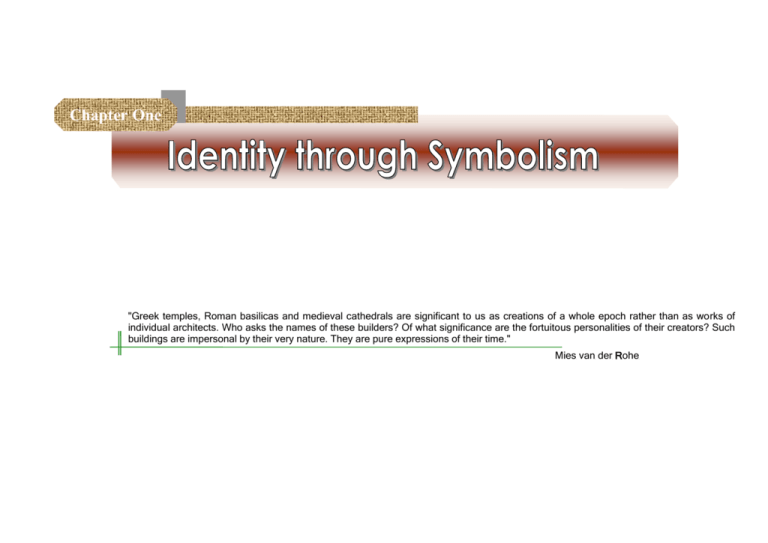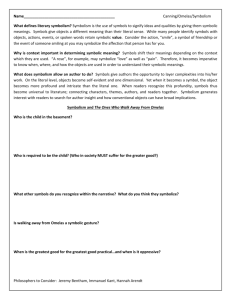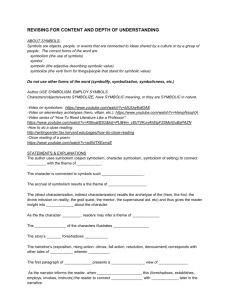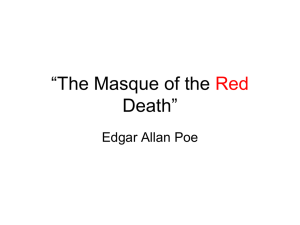Chapter 1 identity through symbolism
advertisement

Chapter One "Greek temples, Roman basilicas and medieval cathedrals are significant to us as creations of a whole epoch rather than as works of individual architects. Who asks the names of these builders? Of what significance are the fortuitous personalities of their creators? Such buildings are impersonal by their very nature. They are pure expressions of their time." Mies van der Rohe Architecture and National Identity Identity through Symbolism 1.1.0 Preview While my intention is not to dwell on the ideology and philosophy associated with all aspects of architecture and nationalism, it is of importance to clarify that architecture is a cultural discourse imbued with ideology. This is evidence in all the works of architecture down the time line. 1.1.1 Architecture The idea of architecture is at one point a ‘thing and an intellectual activity’. In judging architecture we note both ‘the attributes of the thing and the intellectual process’ by which the thing is arrived at. Only with the simultaneous presence of both do we acknowledge architecture.1 Architecture is perhaps the most enduring and expressive of all the types of material culture. As a medium, architecture has a language, or rhetoric of its own; the elements used invoke various historical allusions and ideological connotations. As anthropologist Victor Buchli asserts, “Often the way to understand a given society is to understand the physical and, by metamorphic extension, the social architecture of its organization.”2 Architectural organization inherently reflects in itself, in the styles and elements it employs, an affinity or an agenda. While the discourse of the local against global has been a favourite amongst architectural theorists, these theoretical explorations remain far from being adequate in representing the Fig. 1Parliament buildings in Sofia, Bulgaria, and Belgrade, Yugoslavia by architect Konstantin Jovanovic Source: www.trans-formers.org constituencies central to these theoretical writings. This is so especially when we are discussing a regional identity such a Kenya. The exact relation between architecture and identity remains undiscovered. This search for identity is supposed to follow a consistent line, and care should be exercised not to see 1 Bill Hillier, space is the machine: a configurational theory of architecture, (27 June, 1996) - Cambridge University Press 2 Victor Buchli, An Archaeology of Socialism (Oxford: Berg, 1999), p. 1 2 Architecture and National Identity Identity through Symbolism through western clued-up theories. The power of architecture to represent the ‘local’ requires a thorough re-examining. 1.1.2 National Identity versus Architectural Style Should an architect be defined by his national identity or by the expression of his architectural style? Such was the polemic among historian in reference to architect Konstantin Jovanovic being commissioned to design the Parliament building, itself a construct of nationalist discourse, both in Sofia, Bulgaria, and Belgrade, Yugoslavia. The project "Unification becomes Strength"3, questions the meaning of a Parliament building as a symbol of nationalism, as well as the architect’s right to have an identity of her own other than nationalist. When it comes to the design of government / public building in many of the identity conscious states, I have found out that, not only is the identity expression put to task but also the architect’s identity. It will be disingenuous to conclude that the architects culture and historical background do not make a mark in the architect’s perception and the worldviews. This draws attention to the training and its philosophical / ideological foundation. On a higher level, and in this case the most influential, is the role of the intellectual elites. They have the ability of forging the policy frameworks and with deep understanding of the populace traditions forge the state’s ‘vision’. Fig. 2 Use of the anachronistic architectural style of NeoGothic in the re-facing of the British parliamentary building in the late nineteenth century, a style that reflected the Medieval era, the Gothic style in Britain was rediscovered. Source: www.trans-formers.org Eric Hobsbawm, on the other hand, explains that traditions are often constructed and given a semblance of historical continuity and legitimacy, when in fact these so-called ‘traditions’ are mere innovations of older customs or very novel and relatively recent creations. Often the continuities or meanings claimed were based on misconceptions of the historic past or on myths. He defines the term 'invented tradition' as “a set of practices… which seek to inculcate 3 http://www.trans-formers.org/ 3 Architecture and National Identity Identity through Symbolism certain values and norms of behaviour by repetition, which automatically implies continuity with the past,”4 and cites as an example the use of the anachronistic architectural style of Neo-Gothic in the re-facing of the British parliamentary building in the late nineteenth century. The British intellectual elite, maintaining that the English national character was best embodied in a style that reflected the Medieval era, a period in which English identity was most ‘authentic,’ chose to build an important government building and a prominent national symbol in an antiquated style rather than in the Neo-Classical trend that was then currently en vogue. This conscious choice of style suggested continuity with the past that was not necessarily factual but was rather a revision of history: the Gothic style in Britain had not persisted uninterrupted throughout the centuries but was rediscovered. As Hobsbawm opines, it was not uncommon to find “the use of ancient materials to construct invented traditions of a novel type for quite novel purposes.”5 The Hungarians’ nationalist endeavours and responses to the aforementioned historical stimuli Fig. 3 Old Capitol, USA. Flags are a common element on public/civic buildings and need be integrated in the overall design of the form Source: www.uiowa.edu were representative of a larger movement throughout Europe on the part of nations to assert a unique cultural autonomy within their own state and to distinguish themselves internationally. Many other peoples, in the spirit of self-determination, asserted their own cultural hegemony through a nationalist rhetoric and through the creation of a strong national identity. This endeavour to attain a national distinction often manifested itself through symbols and through material culture. ‘Styles in architecture became the most reflective national symbols’.6 For instance, it is not a coincidence that nations throughout the world utilize a monumental, Neo-Classical style in architecture for their respective governmental buildings. Adorning civic 4 Eric Hobsbawm, “Introduction: Inventing Traditions,” in The Invention of Tradition, eds. Eric Hobsbawm and Terence Ranger (Cambridge: Cambridge University Press, 1992), p. 1 5 Ibid, p. 1 6 Heather N. McMahon, An Aspect of Nation Building: Constructing a Hungarian National Style in Architecture, 1890-1910, Master of Arts, Central European University 4 Architecture and National Identity Identity through Symbolism structures with columns and porticoes makes a conscious reference to ancient Greek or Roman architecture, and to those highly revered civilizations that represent democracy and republican governmental values. Such an allusion lends the government some sense of legitimacy and cultural capital. Thus architecture’s rhetoric is full of latent and manifest ideological references. 1.1.3 "Pitfalls of National Consciousness" As Neil Lazarus suggests in his Resistance in African Literature, one of Fanon's most telling theoretical contributions is his insistence on what he terms the "pitfalls of national consciousness." Nationalism, as Fanon argues in The Wretched of the Earth, often fails at achieving liberation across class boundaries because its aspirations are primarily those of the Fig. 4 ICEA building, Nairobi. Display of the national flag on the building is a routine show of patriotism Source: author colonized bourgeoisie--a privileged middle class who perhaps seeks to defeat the prevailing colonial rule only to usurp its place of dominance and surveillance over the working-class "lumpenproletariat." In the passage below, Fanon explains that "national identity" only carries meaning insofar as it reflects the combined revolutionary efforts of an oppressed people aiming at collective liberation: “A national culture is not a folklore, not an abstract populism that believes it can discover the people's true nature. It is not made up of the inert dregs of gratuitous actions, that is to say actions which are less and less attached to the ever-present reality of the people. A national culture is the whole body of efforts made by a people in the sphere of thought to describe, justify, and praise the action through which that people has created itself and keeps itself in existence.”7 7 Frantz Fanon, The Wretched of the Earth, 1961, Pg 233 5 Architecture and National Identity Identity through Symbolism Contextualising this argument, more emphasis should be put on the architect’s power to express a consistent control and mastery over all these forces that mostly dictate the architectural style. This is challenging as the clients whom the architects seek to serve or from whom they seek to elicit design criteria may be so disoriented by modernization that they cannot express a coherent set of spatial and visual values. 1.2.0 Identity through Symbolism Fig. 5 Soccer monument used as an urban node in a plaza Source: www.cns-snc.ca It is my concern that symbolism in relation to initiating an architectural style with its ‘roots deeply engaged in our traditions but its trunk higher up in the air’ must be informed by extensive study in semantics in African traditional architecture. Architecture must be taken like a language with emphasis not only on the ‘words’ construction but also the ‘spiritual’ meaning decoded. Carol Blair (1999) urges us to ‘look beyond the symbolicity of the rhetorical text and study the materiality of rhetoric with its consequences and partisanship—the material force of rhetoric “beyond goals, intentions and motivations.” In distinguishing between what a text means (symbolic level) and what a text does (consequence level), Blair reminds us that a text— whether in sound, script, or stone—has an existence and meaning beyond authorial intentions.8 It is in this dimension that architectural studies should be geared. I propose that the search for this traditional semantic architecture start with public and government building. However, much of the in put, especially the cultural information on our numerous cultures is not documented. This, therefore, explain why a cultural resource centre should be established. This Fig 6 city council of Nairobi tower will coordinate all the research, documentation, dissemination, and reinterpretation works. It is source: author 8 Carol Blair (1999) 6 Architecture and National Identity Identity through Symbolism only then, that we can make the initial steps towards realizing architecture that converse with the people. 1.2.1.0 Commonly Used Symbols In my research, I have identified the following symbols as the most used to imply the national identity. However, these symbols have also been used to entrench extreme nationalism. They include; the flag, national anthem, songs, sports teams and medals, national dress/uniform religion, language, buildings among others. Symbols such as these create and construct a national identity often made up of many different cleavages of peoples. a. Sports Teams and Medals, Governments are now involved in sport to promote the prestige of a group. The other reason is to encourage a sense of identity, belonging and unity through ‘sporting nationalism’. Fig. 7 Cinderella castle Sport as a diplomatic tool can be considered like a public diplomacy to influence opinion. “Architecture ‘is’ the expression of the very being of societies…It is in the form of cathedrals and palaces that the Church and State speak and impose silence on the multitudes… It is obvious, that monuments inspire socially acceptable behaviour, and often a very real fear.” Sports are a central hobby in our modern society. Sports should be considered entertaining, Bataille, G. (1929): Architecture, Dictionnaire Critique (trans. Paul Hegarty) in Neil Leach ed. (1997) Rethinking Architecture, Routledge, London enjoyable and peacefully passionate. That does not mean academic people should disregard it. Sports have become an instrument of identity9. In every country, sports have become such a large part of the cultural tradition that it has become a way to promote a region, to prove superiority, and/or to affirm existence for national or regional groups. It is therefore appropriate that architects should be informed by this culture and spirit and reflects it in their works. b. Songs, 9 MacClancy, J. 1996, Sport, Identity and Ethnicity, Berg, Oxford, p.12) 7 Architecture and National Identity Identity through Symbolism Alter offers an excellent example of this. National Passions aroused by the Rhine crisis in 1840 produced songs such as ‘The watch of the Rhine’, Nickoloas Becker’s ‘They shall not take the free German Rhine’, and August Heinreich Hoffmann von Fallersleben’s ‘Song of Germany’ later to become the national anthem.10 c. Flag and National Anthem, K.R Minogue states that ‘Flags and anthems can be use to create members of a nation by developing new habits and emotions; the Star spangled banner with its stars increasing as new state joined the Union was an important symbol of America to the millions of immigrants to the United States.’11 ‘Nationalist theory requires that a national anthem should express the deepest aspirations of the nation; and this often means that the words carry a heavy ideological cargo.’ 12 d. Religion, Religion creates its own symbols but these can ‘often be inaugurated into the national consciousness. A nation’s religion in itself can be the defining symbol and aspect of its nationalism’ dictating the ideological position for its people. A good example is the Islam in Pakistan and the religious conflict in Ireland, where nationalism and religion are irrevocably entwined. Religion often plays an important part in the history of a nation also, which helps to create the sense of a national identity through shared history. e. Language National identity through shared history is also symbolized in Language. Anderson states that ‘Languages thus appear rooted beyond almost anything else in contemporary societies. 10 Alter , The Symbolism of Nationalism, 1989:19-20 11 K.R Minogue, Nationalism (1967), p. 114 12 Ibid, p. 115 8 Architecture and National Identity Identity through Symbolism At the same time, nothing connects us affectively to the dead more than language. If English –speakers hear the words ‘Earth to earth, ashes to ashes, dust to dust’ – created almost four and a half centuries ago – they get a ghostly intimation of simultaneity across homogeneous, empty time. The weight of the words derives only partly from their solemn meaning; it comes also from as-it-were ancestral ‘Englishness’.13 The potent ness of language and its role in creating nations is an essential consideration. Great Poets and author’s works written in a nations tongue can be a very effective symbol of that nation. We have only to look at Shakespeare’s wide influence or the works of Machiavelli or Dante to see this. Also, the response to the Austrian implementation of the ‘German language as the governmental lingua franca throughout its multi-ethnic empire, coupled with the writings of the historical philosopher, Johann Gottfried Herder’, in the late eighteenth century which Fig. 8 London City Hall, A glass and steel building in a capital bristling with historic significant stone. The glass is used as a symbol of transparency in both ways, reminding the people inside that they serve the people outside. portrayed ‘the Germans as a conquering people, had an impact on Hungarian nationalism: Source: http://www.glasssteelandstone.com/ completely ‘Germanised.’’14 Surrounded by states comprised of Slavic peoples, the Magyars such variables instilled in the Magyars a fear of becoming assimilated into extinction, or perceived themselves as ‘a small and seemingly ‘threatened’ majority in the multiethnic lands of Hungary’. These Hungarian elite endeavoured to place the Magyar language and cultural mores above those of the numerous minorities in the state, emphasizing their cultural hegemony. g. Buildings Fig. 9 Taj Mahal, of Agra Source: www.indiaheritage.org/ 13 Anderson 1991, p. 145 14 J.G. Herder, Ideas for the History of Mankind (1784-91) in Nationalism: Its Meaning and History, ed. Hans Kohn (New York: Van Nostrand Reinhold Company, 1965), pp. 104-8. Cited in Lonnie R. Johnson, Central Europe: Enemies, Neighbors, Friends (Oxford: Oxford University Press, 1996), p. 132) 9 Architecture and National Identity Identity through Symbolism Like I had mentioned in my abstract, revolutions or changes in a nation’s political, economical and social construct are sealed through the act of building. Great works are designed and constructed as symbols of liberty and democracy, authority, commercial prosperity… To highlight this, let’s take the case of the western world in the latter part of the nineteenth century and the early part of the twentieth century. ‘Many new nations were emerging from the dust of crumbling empires throughout Europe, a period when notions of self-determination emboldened numerous ethnic or cultural enclaves to demand their own states. Whether these nations wanted to assert their own autonomy, distance themselves from a neighbouring power, or claim their cultural hegemony in a region’, all of them looked towards building as a means of declaring their unique cultural identity.15 In Hungary, all the aforementioned causes ‘drove its elite to construct a national identity in part through a national style in architecture’. Hungarian politicians and intellectual elite strove to assert their social and cultural autonomy. Also, the Hungarian cultural elites desired to Fig. 10 Taj mahal plan and elevation Source: http://ignca.nic.in/images produce a style in the arts that was inherently its own.16 This study will therefore, probe into the probability of achieving architectural identity through the use of symbols, with reference to specific detached examples across the world. 1.2.2.0 Architectural Symbolism The search for symbolism within the forms of traditional African architecture is still in its inception and requires extensive elaboration. Several particular forms and signs cut across the divide in terms of; image, technology, materials, social factors, interior configurations, and planning. In developing the symbols in architecture to more contemporary periods, one needs to consider the following; The obligatory and desirable functional and formal elements in a Fig. 11 Taj Mahal, Agra. It uses traditional motifs and elements of Islamic architecture to create a mood of dignity, contemplation and tranquility. Source: Design Strategies in Architecture, by Geoffrey, B. building, the role of this type of building within the urban landscape and within the life of the 15 Heather N. McMahon, An Aspect of Nation Building: Constructing a Hungarian National Style in Architecture, 1890-1910, Master of Arts, Central European University 16 Ibid, p. 12 10 Architecture and National Identity Identity through Symbolism city, and whether this role continues or has been usurped or taken over by other buildings, forms and functions. 1.2.2.1 Contradiction in architectural Symbolism: The Case of Architecture in India In this comparative study by Rahul Mehrotra on symbolism and the search for national identity in India, I will attempt to concentrate on the following issues: What is the symbol’s connection to the socio-political system that created them? What sort of function were they created to serve? What sort of function do they serve? What do they mean to people—and how do they achieve a particular signification? Through the discourse of the symbol, architecture becomes an instrument to understand the identity of a culture. The use of traditional materials and processes asserts a regionalist identity, while imported glass and steel is taken to symbolize quest for seeking an international identity. However, this seems to be a rather simplistic link between the architectural symbol and the corresponding claim of a particular identity.17. The whole process of symbolism is deeper than this generalization and requires a thorough re-examining. “The international style, on the other hand, was the outcome of a rational approach to design, unhampered by historical and cultural restrains’. This explains why it was used in the design of the Chandigarh Capital Complex which ‘symbolises the glorification of independence attained after a long and sustained political struggle. 17 Rahul Mehrotra, www.architecture−identity.de 11 Architecture and National Identity Identity through Symbolism The Master plan is asymmetrical, symbolic of the democratic nature of the state…the high court symbolises three ideas in its structure – the majesty of law, the shelter of law and power and fear of law”18 According to Rahul Mehrotra paper, architectural symbols remain inadequate to describe an identity, since each symbol can simultaneously denote contradictory meanings and contradictory symbols can suggest similar meanings. What follows is a relative investigation of explicit symbols in India. 1.2.2.1.1 Symbol that Denotes Different and Contradicting Meanings a) The Taj Mahal (Agra) represents Love and romance and the aesthetic taste of the culture, The desperate exploitation of labour, the appropriation of resources and the inequity prevalent in that culture. Architecture here simultaneously describes love and tyranny. b) The Capital Complex in Chandigarh A sign of democratic modernism or An indication of western hegemony c) The National Crafts Museum of New Delhi An assertion of Indian identity or Fig. 12 National Crafts Museum of New Delhi The detachment or objectification of the Indian Folk Arts through the formal museum format 1.2.2.1.2 Similar Meanings from Contradicting Symbols a. The existence and growth of the same consumer middle class The Hiranandani Complex (Mumbai) malls-with Greek columns and pediments and Shopping centre of Gurgaon near Delhi- the high-tech glass and steel, 18 Bahga, S., Bahga, S., and Bahga, Y. (1993): Modern Architecture in India. Post-Independence Perspective, Galgotia Publishing Company, New Delhi 12 Architecture and National Identity Identity through Symbolism b. Religious fundamentalism and expensive building processes The new Jain temples in Mumbai-employ traditional materials and processes, the Bahai Temple in Delhi-designed as a high-tech shell structure and c. The state authority The legislative assembly of Bangalore-with its traditional and classical symbols, The assembly of Mumbai-with an imposing modern form and The assembly of Bhopal-that borrows symbols from ancient history 1.3.0 Identity through local This is the architectural expression of the need to assert the local and a desire to embrace the extra-local i.e. international, global, western etc. “The search for roots” and “looking ahead in time” are the two respective positions that get articulated through this concern. Often buildings are conveniently bracketed into themes like “nationalist”, “regionalist” etc. to very clearly distinguish from the other “internationalist” or “global” ones.19 Beyond both these positions, is another position that aims at “looking at real problems, rather than self consciously trying to find identity as an end in itself”20. This position attempts to locate the local in specific issues such as climate, behaviour etc. rather than leaning on oversimplifications of history and progress. 19 Rahul Mehrotra, Prasad Shetty and Rupali Gupte, The Ismaili United Kingdom December 2000, pp. 16-17, 20 20 Correa, C. (1983): Quest for Identity. In Proceedings of the Seminar: Exploring Architecture in Islamic Cultures 1: Architecture and Identity, The Aga Khan Award for Architecture 13 Architecture and National Identity Identity through Symbolism In discussions that focus on the binary understanding of nationalist/internationalist or regional/global, this new category namely “Critical regionalism”21 seeks “contextual inspiration” while simultaneously celebrating the “progressive modern”. I concur with Fredrick Jameson22, whose criticism of Frampton’s “Critical Regionalism” begins by articulating the perceived difference in the various positions on the local, where he suggests that the search for the local (whether in history, progress or climate) itself may be a product of the global multinational capitalism. Jameson tries to suggest that all these positions are actually the functions of the market and in that sense not too different at all. 1.3.1 Local Identity in Institutions This claim is attempted through the utilization of local processes and materials to develop their architecture and attempts to recreate physical scales, symbols and spaces that one would experience in the traditional village or in a pre-colonial town. Does this process of engaging images to represent the past of the locale makes these institutions more local than the others? The following institutions, the National Crafts Museum in New Delhi, the Jodhpur University Complex and the Centre for Development Studies in Tiruanathapuram, present a clear analogy of how the question of identity is deeper and need multi-faceted approach. From this statement, it is clear of my conviction that having search symbols of identity is feasible. It is only the approach that need be clarified. There has been never a museum, a university and an international institute in an Indian village. The contexts of the village never produced such a Programme. Such programmes seem to be a product of an extremely centralised state aspiring to develop institutions to represent its 21 Frampton, K. (1985): Modern Architecture: A Critical History, Thames and Hudson, London 22 Jameson, F. (1994): The Constraints of Postmodernism. In Leach, N (1997): Rethinking Architecture A reader in Cultural Theory, Routledge, London 14 Architecture and National Identity Identity through Symbolism concerns. These were ‘all state projects that were initiated during the years of political emergency’ when projects were being ‘challenged and a quest for regional identities was developing’. This was also the time when a number of regional parties in India developed after the intense centralization imposed by Indira Gandhi 23 all asserting regional identities and in the process building and reinforcing localized constituencies. In such a political environment, then it is obvious that the state would support projects that asserted a high degree of regionalism. In the above examples, ‘architecture uses extreme symbolism to execute such visions of the state’ However, in spite of their claims of a search for a regional identity, the National Crafts Museum remains as much a museum objectifying the village cultures, the Jodhpur University also reflects its education mandate and purpose like any other university in India and the Centre for Development Studies undertakes the best political and cultural studies on par with any International Institute.24 We could identify several writings that suggest attempts to create a nationalist or a regionalist identity. But to find writings that undertake the task of examining whether the respective buildings actually manifest any notion of identity is extremely rare! 1.4.0 ‘Constructing the Nation’ through Architectural Explorations Theoreticians of nationalism studies often overlook the role of material culture in the formation processes of national identities. Material culture is, after all, the tangible manifestation of a culture or a way of life, a way of thinking and perceiving the world. As a body of symbols, it is 23 Chatterjee, P. (ed.) (1997): State and Politics in India. Delhi: Oxford University Press 24 Architecture and Identity by Rahul Mehrotra, www.architecture−identity.de 15 Architecture and National Identity Identity through Symbolism a tool with which we can interpret the essence of a given society.25 As such, material culture reflects how a given society perceives itself, or its collective identity. Forging a national identity through material culture was very common throughout the western world in the latter part of the nineteenth century and the early part of the twentieth. This was a period in which many new nations were emerging from the dust of crumbling empires throughout Europe, a period when notions of self-determination emboldened numerous ethnic or cultural enclaves to demand their own states. In the midst of this phenomenon, most European nations attempted to create a ‘national style’ in architecture and in various other mediums of art in a burst of patriotic (or nationalist) fervour. Architects have designed cities, institutions and buildings with an aim of expressing a specific theme. Cases of “constructing the nation” amongst the subjects through architectural explorations are depicted in; New Delhi, where the state’s attempts at manufacturing a sense of authority,26 Chandigarh, an attempt at expressing a sense of modernity 27 and Bangalore where they try to suggest a sense of tradition28. Fig. 12The monumental KICC amphitheatre, a powerful initiative of the day’s elites is a bold statement that converse with the people to date. Source: author According to Rahul M, revisiting these sites, one fails to observe any traces of ‘authority’, ‘modernity’ and ‘tradition’ in the public realm. On the contrary exactly opposite accounts are available. Architecture here seems too meagre a phenomenon to influence the manner in which nationalism is imagined, experienced and executed. On the other hand, Eric Hobsbawm theoretically articulates how State impositions cannot be considered as identity. “First, official ideologies of states and movements are not guides to 25 Victor Buchli, An Archaeology of Socialism (Oxford: Berg, 1999), p. 1 26 Lang, J; Desai, M. and Desai, M. (1997): Architecture & Independence. The Search for Identity –India 1880 to 1980. Oxford University Press, New Delhi 27 Kalia, R. (1987): Chandigarh - The Making of an Indian City. Oxford University Press. Oxford 28 Lang, J (2002): A Concise History of Modern Architecture in India, Permanent Black, New Delhi 16 Architecture and National Identity Identity through Symbolism what is in the minds of even the most loyal citizens or supporters. Second, and more specifically, we cannot assume that for most people national identification - when it exists excludes or is always or ever superior to, the remainder of the set of identifications, which constitute the social being. In fact, it is always combined with identifications of another kind, even when it is felt to be superior to them. Thirdly, national identification and what it is believed to imply, can change and shift in time, even in the course of quite short periods. In my judgment this is the area of national studies in which, thinking and research are most urgently needed today”.29 Several post-colonial theories on the sub-national, the subaltern and the trans-national identities challenge the grand unifying concept whereby a nation defines the identity of its people. But more importantly these theories situate the identity issue in the political realm rather than in the aesthetics. 1.4.1 Building as Reflectors of Ideology Structures have a dialectical relationship with their inhabitants: they are often built in a style that reflects the Zeitgeist, while they themselves help to advertise and perpetuate that very Zeitgeist’s tenets. Architecture is often employed as a means of professing certain ideologies, making the medium very useful in the attempt to construct a national consciousness. And a national Fig. 6 Ndebele traditional architecture and arte facts. consciousness (or national identity) is a social construct, crafted in order to foster unity and attachment amongst an often-diverse population. Creating consensus and a sense of belonging is necessary for an emerging nation-state, as group formations, or collectives, in 29 Hobsbawm, E (1990): Nations and Nationalism since 1780. Cambridge: Cambridge University Press 17 Architecture and National Identity Identity through Symbolism their very nature instil in individuals feelings of security, confidence and membership.30 Therefore, when we analyse the formation of a national identity, the use of architecture as a medium or even catalyst should be considered an integral component. A national consciousness or a national identity is supposed to reflect the essence of the people of the nation. Often this translates into the symbols of the nation, which are thought to encompass the meaning of the folk. But since structures and insignia are rarely designed by popular consensus, architects and intellectuals have more of a primary role in forging the symbols of a national identity, especially through architecture. Certain structures have been consciously designed with a symbolic nationalist rhetoric in order to spread or re-emphasize a nationalist ideology to the masses that comprise the nation. Anthony Smith maintains that symbols “have always possessed the emotive collective qualities”31 that can band a nation together, and architecture is one of the grandest examples of such a symbol. I interpret ‘symbols’ as material or physical representations that are fraught with latent and manifest meaning, often political or ideological. As George Mosse notes, “Nationalism… made symbols the essence of its style of politics.”32 The symbolic language that the elite implements in its discourse on national identity is crucial to defining and dispersing amongst the populace an ideology of nationhood. Regionalism as an ideology is gradually asserting itself among intellectuals of the concerned with ‘third world’. Explaining the reason why, Brian Brace Taylor writes, “The culture of many Third World countries is, and has been becoming, more and more part of a universal culture. 30 Daniel Bar-Tal, “Group Beliefs as an Expression of Social Identity,” in Social Identity, eds. S. Worchel, J.F. Morales, D. Paez, and J.C. Decamps (London: SAGE Publications, 1998), p. 93 31 Anthony D. Smith, National Identity (London: Penguin Books, 1991), p. 77 32 George L. Mosse, The Nationalization of the Masses: Political Symbolism and Mass Movements in Germany from the Napoleonic Wars through the Third Reich (Ithaca, NY: Cornell University Press, 1975), p. 7 18 Architecture and National Identity Identity through Symbolism This has often transpired for the wrong reasons – imitation for the sake of imitation would be one since the economic, social and even political structures of these societies are different form the western societies they have taken as a model. In some instances, countries newly independent from colonial rule pursued a philosophy of modernization as a strategy towards cultural identity”. 1.4.2 Building as Transmitters of Cultural Values This transmission occurs ‘largely through the configurational aspects space and form in all built environments. For example, we think consciously of buildings as physical or spatial objects and we think of their parts as physical or spatial parts, like columns or rooms, But ‘we think of buildings’ as whole entities through the unconscious intermediary of configuration, in that when we think of a particular kind of building, we are conscious not only of an image of an Fig. 7 Section through the KICC building, Nairobi Sketch: author object, but at the same time of the complex of spatial relations that such a building entails. The spatial and formal patterns that are created through buildings and settlements are classic instances of the problem of non-discursivity, both in the sense of the configurational nature of ideas we think with in creating and using space, and in the sense of the role these play in social knowledge. Fig. 15KICC ground floor plan Source: conference, convention and exhibition facilities by Lawson, F, pg. 13 Built environments’ space varies in the degree to which it is subject to social knowledge, but it is not uncommon for it to be patterned according to codes of considerable complexity which govern what spaces there are, how they are labelled, how bounded they are, how they are connected and sequenced, what activities go together in them and which are separated, which individuals or categories of persons have what kinds of rights in them, how they are decorated, what kinds of objects should be displayed in them and how, and so on. 19 Architecture and National Identity Identity through Symbolism These patterns vary from one cultural group to another, but invariably we handle domestic space patterns without thinking of them and even without being aware of them until they are challenged. In general, we only become aware of the degree of patterning in our own culture when we encounter another form of patterning in another culture This cultural patterning is expressed in artefacts, spatial design and organization, decoration, technology, and material culture. With in-depth understanding about a certain culture and its social philosophy, elite can reconstruct hybrids of traditional values and fuse them with the contemporary culture to come up with an architectural code that transmit or express society’s cultural views. Eric Hobsbawm addresses this phenomenon of cultural symbol construction in his seminal book The Invention of Tradition. He explains that traditions are often constructed and given a semblance of historical continuity and legitimacy, when in fact these so-called ‘traditions’ are mere innovations of older customs or very novel and relatively recent creations.33 1.4.3 Formal Abstractions and Identity It is extremely difficult to find any relations between formal abstractions and identity. A monumental scale does not necessarily indicate and impose power. Rahul Mehrotra gives the example of the Red Fort (Delhi) in all its might, today is one of the most accessible places and the pristine arcades of the Fort area in Mumbai which today harbour a large informal industry. 33 Heather N. McMahon, An Aspect of Nation Building: Constructing a Hungarian National Style in Architecture, 1890-1910, Master of Arts, Central European University 20 Architecture and National Identity Identity through Symbolism ‘These places no longer represent an Empire. They no longer exert power (like Bataille’s monuments) or are symbols of colonization – their symbolism has been inverted, converted and internalised’34. 1.5.0 Conclusions Discourses consistently used in architectural theory to establish the relationship between architecture and identity emphatically highlights both Symbolism and the idea of the local. However, the issue of national identity is complex and ambiguous and cannot be solved unless the effects and manifestations of culture are examined. Let us first examine the theory and observations of symbolism in relation to architecture. Both these discourses ‘symbolism’ and ‘locale’ remain inadequate and sometimes inappropriate to throw any light on the relationship between architecture and identity. It is my concern that symbolism in relation to initiating an architectural style with its ‘roots deeply engaged in our traditions but its trunk higher up in the air’ must be informed by extensive study in semantics in African traditional architecture. Architecture must be taken like a language with emphasis not only on the ‘words’ construction but also the ‘spiritual’ meaning decoded. From these examples we could possibly conclude that the relationship between a symbol and identity is a construction of the architectural theorist and hence it is misleading to discuss the issue of identity on the basis of architecture only. 34 Rahul Mehrotra, Architecture and Identity, www.architecture−identity.de 21








